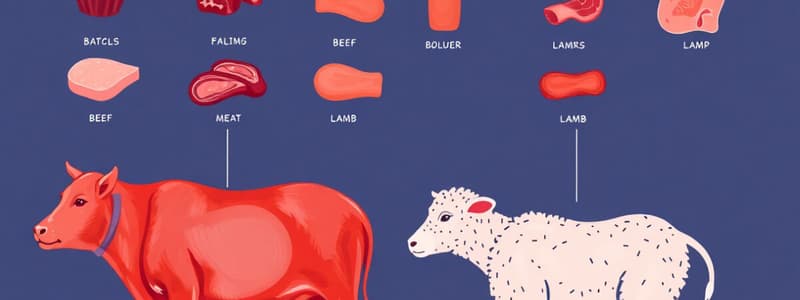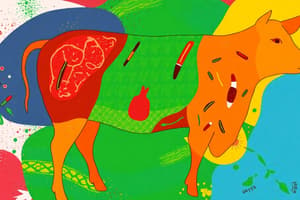Podcast
Questions and Answers
Which type of connective tissue protein increases in concentration as animals age, contributing to meat toughness?
Which type of connective tissue protein increases in concentration as animals age, contributing to meat toughness?
- Myoglobin
- Reticulin
- Collagen (correct)
- Elastin
Which type of fat is found within muscles and contributes to the flavor and juiciness of meat?
Which type of fat is found within muscles and contributes to the flavor and juiciness of meat?
- Cover fat
- Subcutaneous fat
- Visceral fat
- Intramuscular fat (correct)
What happens to the color of meat when it is exposed to oxygen shortly after slaughter?
What happens to the color of meat when it is exposed to oxygen shortly after slaughter?
- It turns yellow
- It turns brown immediately
- It becomes bright red (correct)
- It remains unchanged
What is the recommended cooking method for tough cuts of meat that contain a high amount of collagen?
What is the recommended cooking method for tough cuts of meat that contain a high amount of collagen?
What causes the fat in younger animals to appear white rather than yellow?
What causes the fat in younger animals to appear white rather than yellow?
Which nitrogen compound found in meat contributes to its flavor and is water-soluble?
Which nitrogen compound found in meat contributes to its flavor and is water-soluble?
Which governmental action is mandatory to ensure the safety of meat for consumers?
Which governmental action is mandatory to ensure the safety of meat for consumers?
What change occurs to the color of cooked meat when stored for an extended period?
What change occurs to the color of cooked meat when stored for an extended period?
What is the primary dietary requirement for cattle to be classified as producing organic meat?
What is the primary dietary requirement for cattle to be classified as producing organic meat?
Which factor does NOT directly influence the natural tenderness of meat?
Which factor does NOT directly influence the natural tenderness of meat?
Which of the following best describes the concept of rigor mortis?
Which of the following best describes the concept of rigor mortis?
What is primarily measured by the yield grade of meat?
What is primarily measured by the yield grade of meat?
What happens to muscle extensibility during the rigor mortis process?
What happens to muscle extensibility during the rigor mortis process?
Which condition typically improves meat tenderness through aging?
Which condition typically improves meat tenderness through aging?
Which of the following chemical changes is NOT typically seen postmortem in muscle?
Which of the following chemical changes is NOT typically seen postmortem in muscle?
What is the outcome of slaughtering conditions on meat quality?
What is the outcome of slaughtering conditions on meat quality?
What is the primary distinction between veal and baby beef?
What is the primary distinction between veal and baby beef?
Which type of connective tissue protein is primarily responsible for the structure of meat?
Which type of connective tissue protein is primarily responsible for the structure of meat?
How does the size of muscle fibrils affect the consistency of meat?
How does the size of muscle fibrils affect the consistency of meat?
What is the primary age distinction between lamb and mutton?
What is the primary age distinction between lamb and mutton?
Which of the following statements about muscle contraction is accurate?
Which of the following statements about muscle contraction is accurate?
What distinguishes bulls from steers in cattle classification?
What distinguishes bulls from steers in cattle classification?
What role does collagen play in the cooking of meat?
What role does collagen play in the cooking of meat?
Which meat type is characterized by the meat of sheep over 14 months old?
Which meat type is characterized by the meat of sheep over 14 months old?
What is the primary purpose of hanging meat on the carcass after slaughter?
What is the primary purpose of hanging meat on the carcass after slaughter?
At what temperature range should pre-rigor meat be stored to minimize fiber shortening?
At what temperature range should pre-rigor meat be stored to minimize fiber shortening?
Which cooking method is best suited for tougher cuts of meat?
Which cooking method is best suited for tougher cuts of meat?
What is carry-over cooking?
What is carry-over cooking?
What effect does exposing meat to high temperatures for too long have?
What effect does exposing meat to high temperatures for too long have?
Which method is NOT typically used to determine the doneness of meat?
Which method is NOT typically used to determine the doneness of meat?
What happens during 'cold shortening' in meat?
What happens during 'cold shortening' in meat?
Which of the following statements about moisture removal before meat preparation is true?
Which of the following statements about moisture removal before meat preparation is true?
Flashcards are hidden until you start studying
Study Notes
Meat Types
- Beef comes from cattle.
- Steers are castrated males.
- Bulls are uncastrated males.
- Heifers are females that have not borne a calf.
- Cows are females that have borne calves and are less desirable.
- Calves 3 to 8 months old are too old for veal and too young for beef.
- Baby beef is meat from calves 8-12 months old.
- Veal is meat from calves between 3 weeks and 3 months old, known for its milky flavor, pale color, and tenderness.
- Lamb and mutton are meat from sheep.
- Lamb is from sheep under 14 months old.
- Mutton is from sheep over 14 months old.
Meat Composition
- Meat is composed of water, muscle, connective tissue, adipose tissue, and bone.
- Muscle tissue is the main source of protein in animals.
- Muscle fibers are made of myofibrils which affect meat texture.
- Small myofibrils result in finer muscle bundles and soft consistency.
- Myofibrils are separated into sarcomeres.
- Actin and myosin are proteins in sarcomeres that slide past each other during muscle contraction, forming actinomyosin.
- Connective tissue holds the muscle cells together.
- Collagen is the most abundant protein in connective tissue.
- Collagen toughens meat but softens when exposed to moist heat.
- Elastin and reticulin are the other two connective tissue proteins.
- Muscles with more connective tissue, like those in the neck, shoulders, legs, and flank, are tougher.
- Loin and rib muscles are more tender due to less exercise.
- Older animals have more collagen, making their meat tougher.
- Tougher cuts require slow, moist cooking to soften the collagen.
- Adipose (fatty) tissue is fat.
- Cover fat is on the outside of meat.
- Intramuscular fat or marbling is found within the muscle.
- Fat content varies based on breed, age, diet, and exercise.
- Well-marbled beef is more expensive.
- Fat color turns yellow with age due to carotenoid pigments in the feed.
Meat Color
- Meat color comes from myoglobin and hemoglobin.
- Myoglobin changes color with oxygen exposure, turning bright red and then brownish-red.
- Cooking meat initially turns it bright red, then denatures it to grayish brown.
- Stored cooked meat can turn yellow, green, or faded.
- Nitrites are added to processed meats to prevent discoloration.
- Extractives, including creatine, creatinine, urea, and uric acid, contribute to meat flavor.
Purchasing Meat
- Government laws require meat inspection for safety.
- Yield grades and quality grades are voluntary and help consumers choose meat.
- Organic meat is from cattle raised exclusively on milk, grasses, and grains.
- Yield grade measures the amount of lean meat on the carcass.
Meat Tenderness
- Tenderness is influenced by cut, age, fat content, and treatment.
- Tender meats benefit from dry heat cooking (roasting, broiling, grilling, pan-broiling, frying).
- Tougher cuts are suitable for moist heat cooking (braising, simmering, stewing, steaming).
- Natural tenderizing factors include:
- Cut of meat
- Age (lower collagen content in younger animals)
- Marbling (intramuscular fat)
- Slaughter conditions
- Aging
- Rigor mortis is the temporary stiffening after death.
- Aging is the ripening process that involves hanging carcasses in refrigerated environments.
Postmortem Muscle Changes
- Pre-rigor mortis:
- ATP decreases
- Lactic acid buildup in cells
- pH decreases
- Glycogen decreases
- Muscle becomes more extensible
- Rigor mortis sets in
- Rigor mortis: Muscle stiffens and becomes less tender.
- Post-rigor stage: Muscle relaxes and becomes more tender.
- Meat pH: After slaughter, the pH gradually decreases due to lactic acid accumulation.
Minimizing Muscle Shortening
- Hanging carcasses after slaughter stretches muscles, reducing actomyosin cross-linking.
- Pre-rigor temperature control minimizes fiber shortening, optimal temperature is 15–20 C (59-68 F).
- Higher temperatures increase shortening.
- Lower temperatures cause "cold shortening" due to calcium ions remaining in the sarcoplasm.
Meat Preparation
- Meat should be cleaned with paper towels and trimmed of fat before cooking.
- Doneness is determined by time/weight charts, color changes, internal temperature, and touch.
- Processed methods like curing, smoking, canning, and drying were used before refrigeration.
Changes During Heating
- Proper cooking time and temperature maximize tenderness, juiciness, and flavor.
- High temperatures for extended periods toughen, shrink, and harden meat.
- Carry-over cooking continues cooking after removal from heat, distributing heat more evenly.
- Doneness can be determined by various methods.
- Touch as a test for doneness: Pressing lightly on the center of the lean tissue can help determine if meat is rare, medium, or well done.
Studying That Suits You
Use AI to generate personalized quizzes and flashcards to suit your learning preferences.



